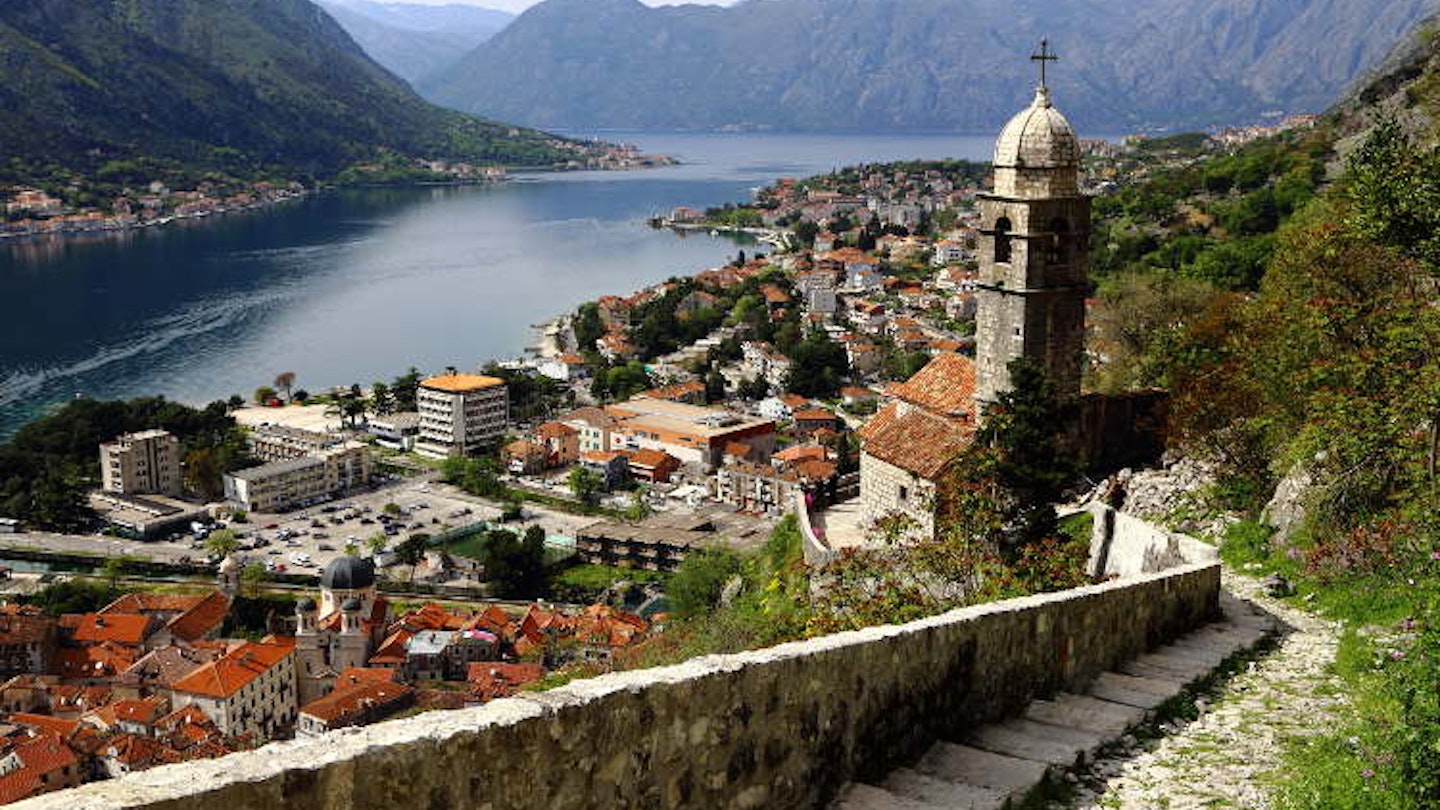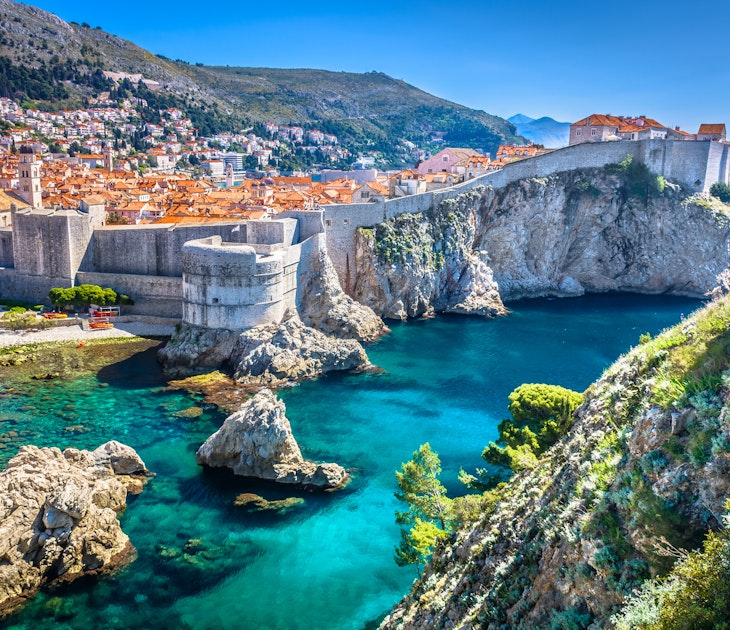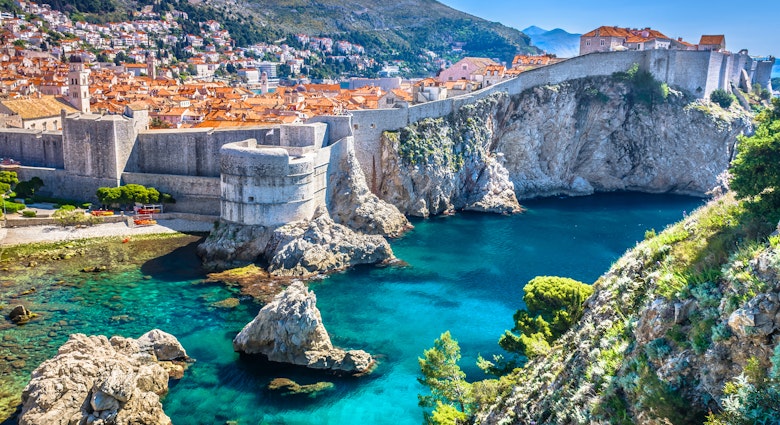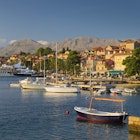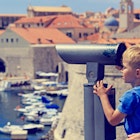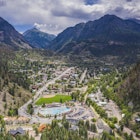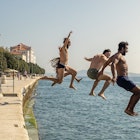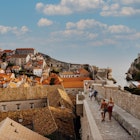The prettiest and best-preserved town in Montenegro, Kotor wears its elaborate fortifications like tough, spikey armour; yet behind the city walls lies a disarming core of piazza-fronting churches, cobbled arteries and quirky shops – all in the embrace of one of Europe’s most spectacular bays. Here’s our guide to a perfect weekend in this teeny-tiny Unesco-listed city.

Friday
As you face Kotor’s brooding Sea Gate, the main entrance to its Stari Grad (Old Town), it’s immediately obvious that this diminutive fort town was once a prized outpost of the Venetian empire, which lorded over Kotor for nearly 400 years. The squat city walls that encircle the 17th-century heart of Kotor are fiercely guarded by the winged lion of St Mark (Venetian symbol of power) – you’ll see it stamped into the ancient stone like a grand seal of approval.
Just beyond the gate, Kotor has a more welcoming beating heart. Slip into the rhythm of city life with a coffee at one of the pavement cafes that throng Trg od Oružja (Weapons Square); the clink of cups and murmur of chit-chat reverberate off the shuttered houses that hem in this broad cobbled piazza. If you’re feeling peckish, grab a sugar-dusted cherry strudel – a delicious local speciality – from the bakery on the square to nibble as you tour the town.
Part of Kotor’s addictive appeal is that it’s not a town of museums or major sights: it’s simply a darling place to dip in and out of piazzas, shops and cafes that peak out from old stone buildings, secreted down wonky alleyways. Dedicate at least part of the morning to wandering aimlessly around Stari Grad, which happily is a car-free zone.

Don’t miss the traditional cobblers around the corner from St Nicholas’ Church, where you can still see opanci (traditional Balkan peasant shoes made of woven leather) being lovingly crafted. Stop by Antiques Stanković, one of many antique dens in the city, for a natter about Balkan history amid a magpie’s hoard of treasures from centuries of Venetian, Austrian and Yugoslav influence.
Next, ascend Kotor’s fortified walls so that you can ogle it from a different perspective. The tourist-friendly Citadella bar, jutting out on a bayside corner of the wall, is justifiably popular for its unbeatable views of the bay, town and looming Mt Lovćen – the city’s Escher-like battlements creep dizzyingly skywards behind Kotor.
Wine-producing is a way of life in Montenegro yet it may come as a surprise that the local drop is delicious, as well as great value. Late afternoon is the perfect time for tasting and the Old Town is laced with wine shops. Mon Ami Wine House is a superb place to familiarise yourself with the local vranac grape before settling in for an evening at one of Kotor’s atmospheric bars.

Saturday
Make a beeline for Kotor’s earthy food market where local producers and shoppers descend each morning to sell and pick up delicious home-grown goodies: a self-catering tourist’s dream. Operating out of chambers in the city walls, friendly market traders will offer up samples of local pršut (smoke-dried ham) and sir (smoked cheese, sometimes infused with walnuts and pistachios), which are trademarks of the region.
Armed with a picnic fit for a Venetian prince, and plenty of water, it’s time to tackle Kotor’s most astounding sight: an ambitious extension of the town’s defensive fortifications, which snake up the foothill of the Lovćen massif like the spikey tail of a slumbering dragon. They began heading uphill behind town in the 9th century and were gradually extended over the following 1000 years to form a protective ring around the city. Huff and puff your way up a crumbling ladder of 1350 steps to St John’s Hill, where a minute chapel and superb panoramic bay views reward climbers. Welcome to Kotor’s most breathtaking lunch spot.
If you’re here in summer, in the afternoon take to the bay in a kayak with Kayak Montenegro. Cradled in the deepest recess of the Bay of Kotor, the city’s shores do not make ideal swimming spots, but Kotor’s waterways and positioning shrouded by Montenegro’s famed black mountains make it a picturesque place to explore from the water. To get further afield, hop on a boat to be whisked off to neighbouring Perast. This quaint medieval village dripping with Venetian palazzos has a little promenade with views out to Gospa od Škrpjela (Our-Lady-of-the-Rocks): a tiny island dominated by a grand domed church and an ice-cream shop, where your boat will drop you off.

Sunday
It’s time to get out of town, and the choice is bay or mountains. Every fold of the spectacular Bay of Kotor reveals photogenic vistas and historic villages, but in summer months the slim road can be clogged with traffic and the drive can be slow going (buses also make the trip, but it’s easier to explore if you rent a car).
In the opposite direction, the 25 hairpin bends of the back road to Mt Lovćen (1749m) make for a tempting alternative escape. Each switchback scaling up into the clouds shows off the terracotta roofs of Kotor splayed out below and the azure bay beyond. Local rakija (fruit brandy) stalls line the way and at the top, cloaked in clouds, lies moody, wooded Lovćen National Park. Speckled with ruins of old houses and traditional smoking sheds, herein lies some of Montenegro’s best walking country.
At its heart sits the village of Njeguši, famed for its smoked cheese and ham, but also a prime spot to try mountain specialities such as herb-laced roast lamb. Head to cosy timber-framed Konoba kod Radonjića, where you can chow down on this traditional dish in front of a roaring fire, even in May when the mountains might still be shivering in snow. Deeper into the park the incongruous hulk of Njegoš Mausoleum sits spectacularly atop a peak, fronted by giant granite goddesses which guard the tomb of Montenegro’s greatest hero, Petar II Petrović Njegoš.

Make it happen
Tivat airport is less than 10km from Kotor and a taxi costs about €10 (there are no direct buses from the airport to Kotor city centre). However, you’ll find it’s usually cheaper to fly into Podgorica airport (two hours from Kotor) or Dubrovnik airport in Croatia (90 minutes from Kotor) where a wider selection of flights are available.
Kotor’s Stari Grad is crammed with historic apartments and hotels, but in such close quarters remember to pack your earplugs. For a stay right out of a fantasy realm, book into kooky Hotel Astoria where the corridors resemble caves and the decor has a dash of Game of Thrones.
